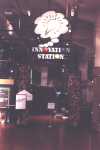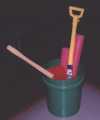
Hall Side

Front

Entrance

Schematic

Back

"Auto" Side

With Bleachers

Platform
The Rolling Ball Web
An Online Compendium of
Rolling Ball Sculptures, Clocks, Etc.
By David M. MacMillan et. al.
"Innovation Station" is a participatory activity at the Henry Ford Museum in Dearborn, Michigan. It's basically a large interactive docent-guided rolling-ball educational device.
The basic premise is that the exhibit teaches the value of innovation through participating in the operation of a large machine - in this case a rolling ball machine. It is "played" by a main exhibitor with the assistance of about 8 docents and up to about 25 members of the (up to) 100 person audience. We had about 25 audience members in total on the Monday morning in which I participated in this activity.
Physically the machine is a sorting machine. On one side (the back side in the photos below) are two sets of large vertical tubes each containing three "augers" or "screws" to lift the balls. These are powered by the first four volunteers from the audience, who spend the rest of the demonstration on exercycles and stair machines providing power.
The auger lift tubes are interesting from a technical perspective. If you just take an auger (or a twist drill or a similar solid helix) and put it in a close fitting tube and try to raise a ball with it, very little will happen. Normally, to use an auger or helix to raise a ball you must also constrain the ball (e.g. between two vertical rods) so that the auger "screws" the ball up a vertical path. The opposite of this can be found in some early descending ball powered clocks where a ball descended in a helical path down an "auger" and carried a cage with it; the movement of the cage powered the clock.
Here, they just had augers in tubes. The reason it worked (I think) is that they had the augers COMPLETELY full of balls. There was a big reservoir of balls underneath, and the balls touched each other in a single "solid" line all the way up the auger. I think that the action here is atually sort of like drilling. If this analogy isn't too farfetched - consider drilling slowly into a piece of soft metal. You're apt to get a shaving working its way back along the spiral of the twist drill. Think of the relatively solid reservoir of balls as like this soft metal - the balls pushed up the auger are very much like a solid shaving being pushed back along a drill.
In the Rolling Ball Technology pages I've referred to this type of lifting screw/auger as a "pressurized screw" because (I think that) the balls operate as if they were a contained fluid under pressure.
Anyway, I'd never seen this particular mechanism before.
The balls are soft rubber.
Once lifted up to near the ceiling, the balls roll down two long tracks (one from each auger). Reflectors above these solid tracks allow the balls to be seen. They roll into two large bins from which two teams of players attempt to distribute the balls as evenly as possible to three sorting stations. I was not able to see the mechanism employed at these distribution stations.
The balls then go to three sorting stations, where teams attempt to sort the incoming balls by color. I was at a station which consisted of a largish wire mesh cylinder. (Much of the look and feel of the whole machine was expanded wire mesh.) The balls entered through a chute at the top. There were three holes into which they were to be directed - red, yellow, and blue. There were three "waste" holes into which they could fall as well. The floor of the unit was at waist height, and in the middle was a circular depression in which balls could collect. The three players manipulated long sticks with holders on the end of them to attempt to place the balls in the right hole. One stick (used by the docent) had a net on the end. The other two sticks had old shoes with metal cups where your ankles would be.
Halfway through the demonstration, we were instructed to "innovate" by being given various plastic push sticks and such.
My sorting station was staffed by myself, a young docent, and a kid. The kid, who must have been about twelve, lost interest and left partway through. The docent and I had a lot of fun, though, putting the colored balls in the holes and generally feeling as if we were twelve again. I guess being twelve just isn't what it used to be. Probably never was :-)
I didn't operate the other stations.
From the sorting stations, the balls went through a rather complex nest of mostly solid PVC tubing to three "filtering" stations. It was the job of the players at these filtering stations to filter out any wrongly colored balls that we sorters had sent them. From the filtering stations, the balls were collected in bins. The "waste" balls from all stations in the machine were also collected in a bin.
At the end of the play session, the master of ceremonies collected everyone back on the benches and talked about various words which constituted Innovation (communications, change, cooperation, etc.) He solicited these words from the audience.
A word about the photos: These photos were taken by A. J. LoCicero, to whom thanks is due. The photos were taken in an extremely difficult situation. While the Henry Ford Museum building is very beautiful, from a photographic standpoint its interior is a big, dark hall which seems to absorb light. The distances for many of the shots were such that flash was ineffective. Even with 1600 speed film, many of these shots turned out rather dark. However, without AJ's photographic skills they wouldn't have turned out at all. I verified this earlier by attempting to take photos myself. None of my photos turned out at all.
Click on the thumbnail images below to bring up larger images. If your browser supports the "target" extension, each larger image should appear in its own, new, window. If this happens, then when you're done viewing this new window, use your browser's "Close" button or menu item to close it (the "Back" button probably won't work). If instead this image replaces the current page, then use your browser's "Back" button to return to this present page.
The numbers of the photos simply indicate the order in which I scanned them.
The exhibit is rectangular in shape, with the front on one of the narrow ends of the rectangle. I'll refer to the four sides, starting from the front and walking clockwise (to the left) around it as: front, hall, back, auto. The "hall" side is the side facing the main hall through the museum. The "auto" side is the side next to the auto exhibits. It isn't actually possible to walk around the exhibit without wandering into other exhibits (a wonderful cable-winding machine, for example).
 Hall Side |
|||||
 Front |
 Entrance |
 Schematic |
 Back |
||
 "Auto" Side |
 With Bleachers |
 Platform |
|||
 From Front |
 From Back |
 From Back |
The "Energizers" (lifting screws/augers), Stations 1 and 2, are two large mesh tubes each containing three smaller mesh tubes with augers. Each Station is powered by two volunteers. They raise the balls up into two long overhead tracks. Since these tracks are solid, they have mirrors above them to allow the balls to be seen as they roll.
 From Front |
 From Back |
 From Hall |
 Lower Part |
 Upper Part |
 Top |
 Power Input |
 Power/Base |
 Base |
 Balls |
 Ball Pit |
The "Senders," Stations 3 and 4, receive the balls from the two overhead suply lines, as supplied by the power augers/screws (Stations 1 and 2; you can see the reflections of the mirrors atop these supply lines). One Sender (Station 3) then sends balls on to the square Distributor (Station 6), while the other Sender (Station 4) sends balls on to the round Distributor (Station 5).
 Sender (Sta. 4) |
 Sender (Sta. 4) |
 Sender (Sta. 4 & 3) |
 Sender (Sta. 3) |
 Sender (Sta. 3) |
The Distributors (Stations 5 and 6) send the balls on to the three Sorters (Stations 7, 8, and 9). The round Distributor is Station 5; it receives its balls from Sender 4. The square Distributor is Station 6; it receives its balls from Sender 3.
 General View |
 General View |
 Station 5 |
 Station 5 |
 Station 6 |
 Station 6 |
The Sorters (Stations 7, 8, and 9) sort the incoming balls by color. Balls may also be sent by the sorters to a "waste" bin.
 Sorter (Sta. 8) |
 Sorter (Sta. 8) |
 Tubes |
 Sorter (Sta. 7) |
 Sorter (Sta. 7) |
 Tools |
The "Tube Maze" (my term) located between the Sorters and the Filterers.
 |
 |
 |
 |
 |
Each Filterer (Stations 10, 11, and 12) receives balls from (I believe) all three Sorters. The intent is that each Sorter will have sorted the balls such that each Filterer receives only one color ball. If balls of a different color make it to the Filterers, it is their job to filter out the unwanted balls. They are the last processing step before the collection of the final "product" (sorted balls). Filterer Station 10 filters yellow balls, Station 11 filters red balls, and Station 12 filters blue balls.
 Sta. 10 |
 Sta. 10 |
 Sta. 10, 11 |
 Sta. 12 |
 Tools |
 |
 |
 Filterer? |
 Filterer? |
 Sign (140K image) |
 Side Wall |
 ? |
 ? |
With the exception of any material noted as being in the public domain, the text, images, and encoding of this document are copyright © 1998 and 1999 by David M. MacMillan and A. J. LoCicero.
This document is licensed for private, noncommercial, nonprofit viewing by individuals on the World Wide Web. Any other use or copying, including but not limited to republication in printed or electronic media, modification or the creation of derivative works, and any use for profit, is prohibited.
This writing is distributed in the hope that it will be useful, but "as-is," without any warranty of any kind, expressed or implied; without even the implied warranty of merchantability or fitness for a particular purpose.
In no event will the author(s) or editor(s) of this document be liable to you or to any other party for damages, including any general, special, incidental or consequential damages arising out of your use of or inability to use this document or the information contained in it, even if you have been advised of the possibility of such damages.
In no event will the author(s) or editor(s) of this document be liable to you or to any other party for any injury, death, disfigurement, or other personal damage arising out of your use of or inability to use this document or the information contained in it, even if you have been advised of the possibility of such injury, death, disfigurement, or other personal damage.
All trademarks or registered trademarks used in this document are the properties of their respective owners and (with the possible exception of any marks owned by the author(s) or editor(s) of this document) are used here for purposes of identification only. A trademark catalog page lists the marks known to be used on these web pages. Please e-mail web@lemur.com if you believe that the recognition of a trademark has been overlooked.
Version
1.3, 1999/03/20.
Feedback to web@lemur.com
http://www.database.com/~lemur/rb-is.html
Go to the: